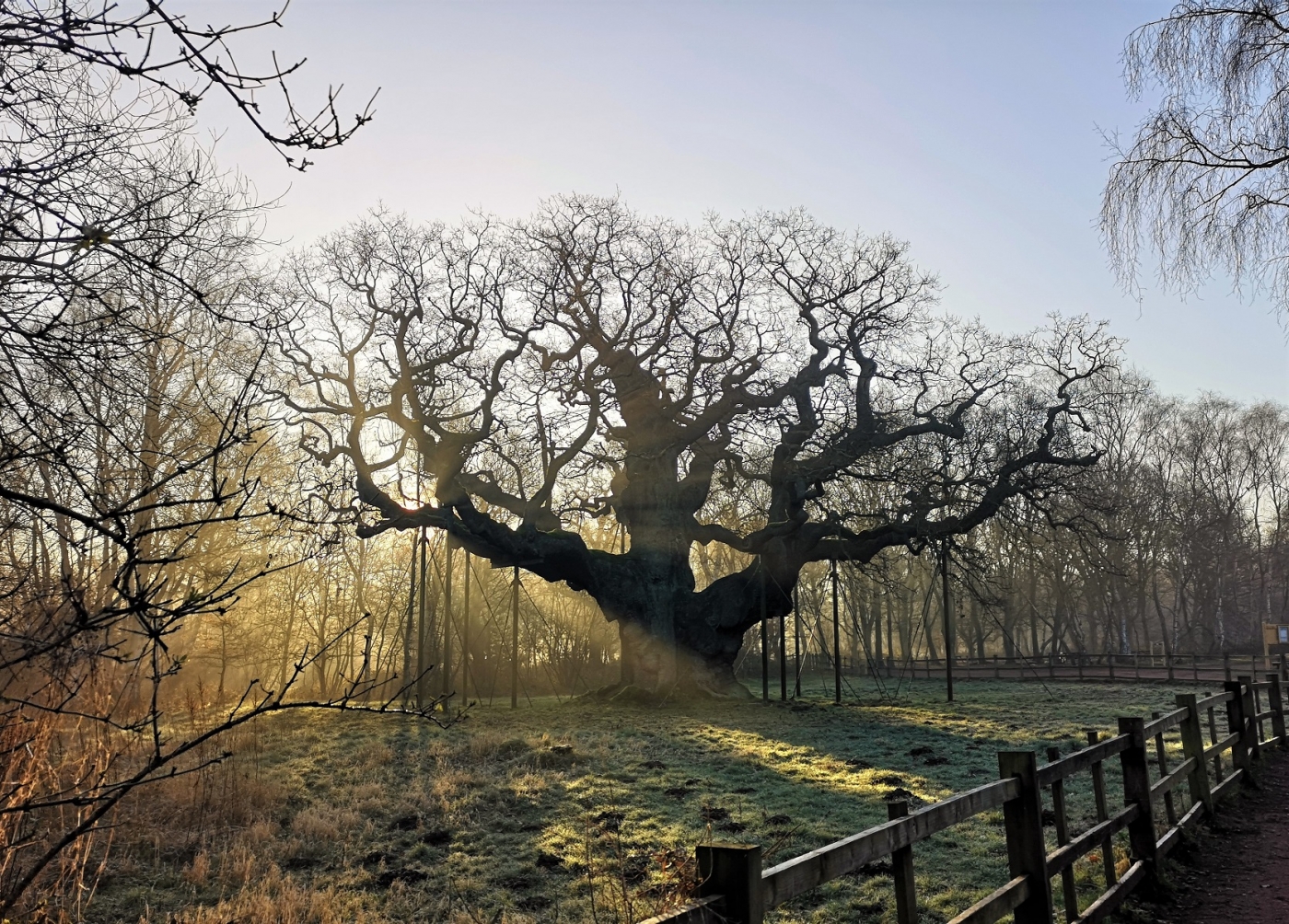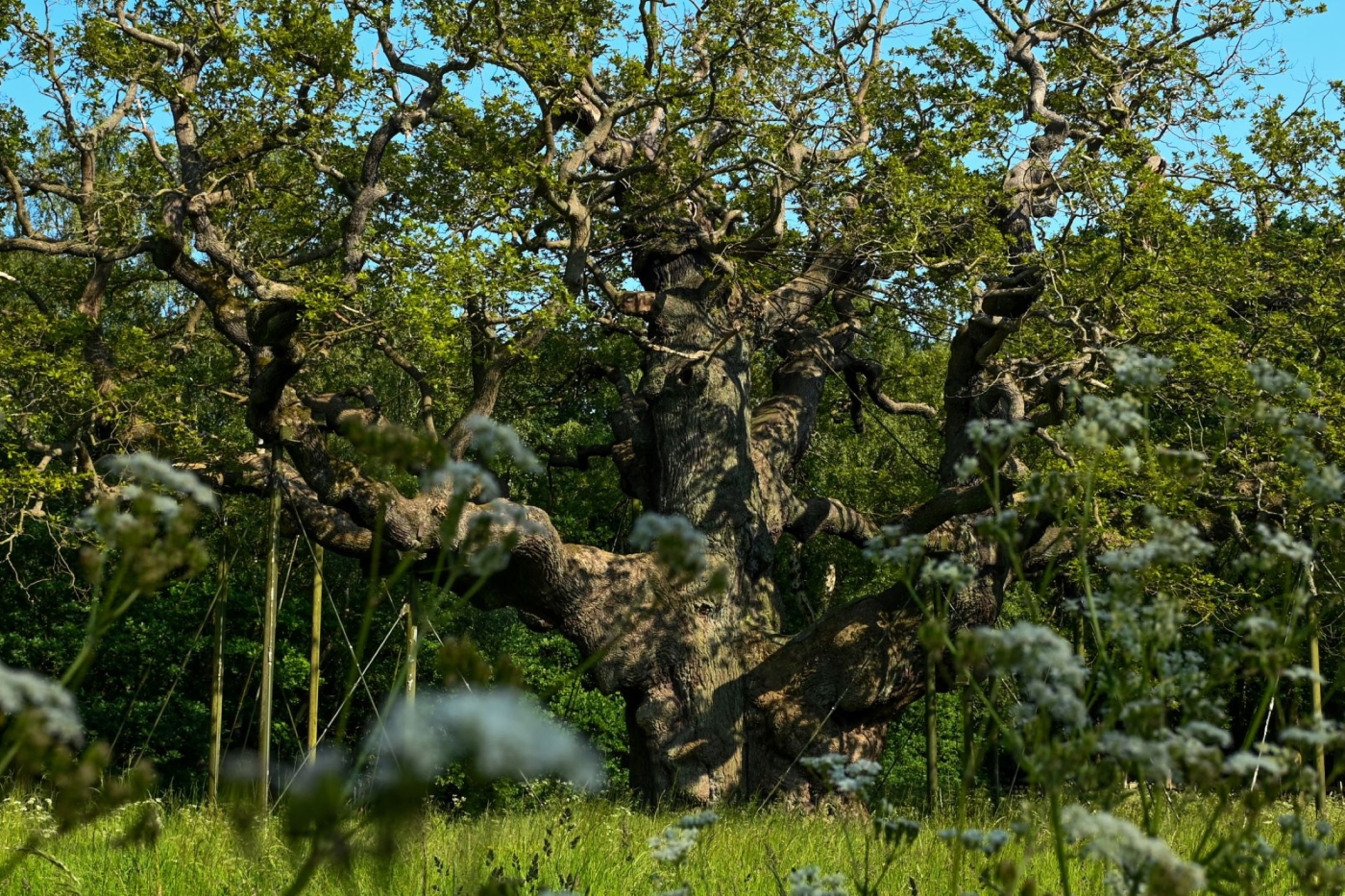The Major Oak
Probably the most famous resident of Sherwood Forest (after Robin Hood of course), the iconic Major Oak is an ancient giant that absolutely cannot be missed.
Only a 15-minute walk from the new visitor centre, follow the Major Oak Trail through the forest from the visitor centre.
Keep your eyes peeled when you follow this route, as you’ll also encounter some of Major Oak’s ancient, gnarled neighbours that make Sherwood so special!
In 2022, the Major Oak was selected as one of 70 ancient trees from around the UK which took their place in the Queen’s Green Canopy, a 70th Jubilee programme to inspire the planting of new trees across the country.
Want all the facts on this legendary giant before you visit? You can get to know the Major Oak by reading our FAQ’s below:

The Major Oak in December. Photo by Lucy Hodson.

And in June. Photo by Tammy Herd.
So, how old is the Major Oak?
Whilst no one knows an exact age, we do know it’s been standing for anywhere between 800 – 1100 years. If we go by the earliest estimate, it has stood through the Vikings, the Battle of Hastings, Agincourt, Waterloo, the births and deaths of Shakespeare, Henry VII, Dickens, Darwin, Newton, Chaucer, Cromwell, the two world wars, over 50 monarchs… it’s seen a lot!
During that time, it’s survived fire, raging winds, heavy snowstorms and hundreds of years of deforestation. It has watched as millions of people from all over the world have gathered around it to stare up at its branches.
Our work in the forest will continue to protect the Major Oak and its fellow giants for the years to come, as well as helping raise the next generation of ancient oak trees for the future of Sherwood Forest!
Just how big are we talking?
The Major Oak is arguably the best known and certainly one of the biggest oak trees in Britain, with a canopy spread of 28 metres, a trunk circumference of 11 metres and an estimated weight of 23 tonnes.
It’s not clear whether the Major Oak is one tree or multiple saplings that have fused together.
The soil below is also relatively poor and acidic, meaning the oak has had to take things steady, slowly growing over a long time to reach this size. It seems to have grown up in a clearing for most of its life, being able to grow outwards without having to compete against other trees. This is what allowed the Major Oak to spread its great boughs and fill as much space as possible.
Although it’s undeniably big, it’s not called the Major Oak because of its size. In 1790, soldier and antiquarian Major Hayman Rooke (1723-1806) wrote a book detailing the oak trees of the area and people began to refer to it as the Major Oak in his honour.
What are the fences and supports about?
In years gone by, it was possible to walk right up to Major Oak, and even climb inside it. Unfortunately, the tree’s popularity meant its roots began to suffer from compaction, caused by the footsteps of thousands of people coming to see it each year. It’s been fenced off since the 1970s, allowing our visitors to appreciate its magnificence whilst also giving it a little room to breathe and stay healthy!
The chains attached to the Major Oak’s crown were fitted in 1908, whilst the first supports holding up the impressive boughs were installed during the 1970s before being updated with metal structures in the 2000s. With the help of these supports, there’s no reason to think the Major Oak won’t keep going for a while yet!
Allowing natural growth around the tree
This area are around the Major Oak is purposely being left to grow naturally to benefit its health.
Allowing the natural growth cycle to follow its course will help to retain vital nutrients in the ground and eventually reduce soil compaction.
This will allow those essential nutrients and rainwater to reach the tree’s vast but vulnerable root system, and allow movement through the soils of micro-organisms and mini-beasts.
It’s all part of our long-term strategy to retain Sherwood’s vital place as one of Europe’s most important ancient oak woodlands for generations to come.
What do the legends say?
While we’re on the topic of the Major Oak and history, there’s one character we can’t ignore – Robin Hood.
Legend has it that when the forest was home to this famous outlaw, Robin and his Merry Men used the Major Oak for shelter; camping beneath its branches and hiding inside its massive trunk.
Nowadays, the Major Oak provides a home and shelter to hundreds of living things; beetles, bats, fungi, squirrels and spiders amongst much more!
Inside the Major Oak canopy
While health checks on the Major Oak were being carried out in July 2023, we took the rare opportunity to go up in a cherry picker to film inside the Major Oak canopy.
Radar survey of the Major Oak 2018
Watch this fascinating video about a study of the Major Oak and the root system under the ground.